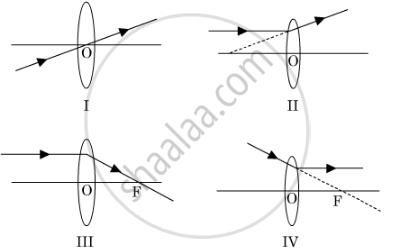Advertisements
Advertisements
प्रश्न
Draw a ray diagram to show the formation of image in the above situation
उत्तर

APPEARS IN
संबंधित प्रश्न
To determine the approximate focal length of the given convex lens by focussing a distant object (say, a sign board), you try to focus the image of the object on a screen. The image you obtain on the screen is always
(a) erect and laterally inverted
(b) erect and diminished
(c) inverted and diminished
(d) virtual, inverted and diminished
A student has obtained a magnified image of a flame on a screen using a convex lens. To draw the corresponding ray diagram to show the image formation, which of the following two rays whose paths after refraction are shown, should he select ?

(A) I and II
(B) II and III
(C) III and IV
(D) I and III
Draw a ray diagram to show the formation of the image of an object be placed so that a real and inverted image of the same size as the object is obtained using a convex lens
Complete the following table:
| Instrument | Number of Convex Lenses |
Use |
| Simple Microscope | .............. | .............. |
| Compound Microscope | .............. | .............. |
| Telescope | .............. | .............. |
If an object is placed at the focus of a convex lens, where is the image formed?
Define principal axis, principal focus and focal length of a convex lens.
Describe with the help of a ray diagram the nature, size and position of the image formed when an object is placed in front of a convex lens between focus and optical centre. State three characteristics of the image formed.
The focal length of a thin convex lens is ______ than that of a thick convex lens.
State the position of object, position of image, nature of image when: Convex lens is used as objective lens of photographic camera.
A concave mirror and convex lens are held in water. What changes, if any, do you expect in their focal length?
